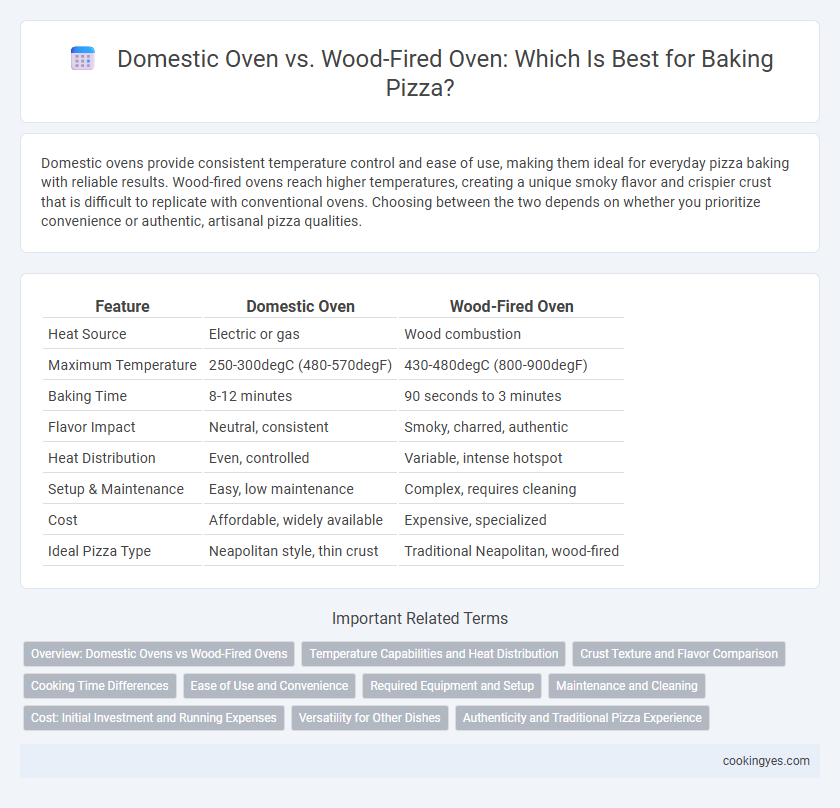Domestic ovens provide consistent temperature control and ease of use, making them ideal for everyday pizza baking with reliable results. Wood-fired ovens reach higher temperatures, creating a unique smoky flavor and crispier crust that is difficult to replicate with conventional ovens. Choosing between the two depends on whether you prioritize convenience or authentic, artisanal pizza qualities.
Table of Comparison
| Feature | Domestic Oven | Wood-Fired Oven |
|---|---|---|
| Heat Source | Electric or gas | Wood combustion |
| Maximum Temperature | 250-300degC (480-570degF) | 430-480degC (800-900degF) |
| Baking Time | 8-12 minutes | 90 seconds to 3 minutes |
| Flavor Impact | Neutral, consistent | Smoky, charred, authentic |
| Heat Distribution | Even, controlled | Variable, intense hotspot |
| Setup & Maintenance | Easy, low maintenance | Complex, requires cleaning |
| Cost | Affordable, widely available | Expensive, specialized |
| Ideal Pizza Type | Neapolitan style, thin crust | Traditional Neapolitan, wood-fired |
Overview: Domestic Ovens vs Wood-Fired Ovens
Domestic ovens typically reach temperatures up to 500degF, providing consistent heat for evenly baked pizzas but lacking the intense high heat needed for authentic Neapolitan-style crusts. Wood-fired ovens can reach temperatures above 900degF, creating rapid cooking environments that produce characteristic charred, crispy edges and smoky flavors. The choice between domestic and wood-fired ovens significantly impacts pizza texture, flavor profile, and baking time.
Temperature Capabilities and Heat Distribution
Wood-fired ovens reach temperatures up to 900degF (480degC), providing intense and even heat that crisps the pizza crust quickly while maintaining a chewy interior. Domestic ovens typically max out around 500-550degF (260-290degC), often resulting in longer cooking times and less consistent heat distribution. The superior heat retention and radiant heat from wood-fired ovens enhance flavor development and texture compared to the more variable heat zones found in domestic ovens.
Crust Texture and Flavor Comparison
Domestic ovens provide consistent heat, resulting in a uniform crust that tends to be softer and less charred, ideal for achieving a chewy texture with even browning. Wood-fired ovens reach higher temperatures of 800-900degF, creating a unique crust characterized by blistered, smoky, and crisp edges with a light, airy interior. The intense heat and open flame of wood-fired ovens infuse pizzas with distinctive smoky flavors that domestic ovens cannot replicate, enhancing the overall flavor profile.
Cooking Time Differences
Domestic ovens typically take longer to cook pizzas, averaging 10 to 15 minutes at around 450degF (232degC), while wood-fired ovens can reach temperatures above 800degF (427degC), reducing cooking time to 2 to 5 minutes. The higher heat intensity in wood-fired ovens creates a distinctive crisp crust and charred flavor that domestic ovens struggle to replicate. Faster cooking in wood-fired ovens also helps retain moisture and enhances the overall texture of the pizza.
Ease of Use and Convenience
Domestic ovens offer precise temperature control and consistent heat distribution, making them highly convenient for everyday pizza baking with minimal effort. Wood-fired ovens require more skill to manage fire and heat levels, resulting in a steeper learning curve but delivering unique smoky flavors and charred crust textures. For ease of use, domestic ovens are ideal, while wood-fired ovens cater to enthusiasts seeking authentic, artisanal pizza experiences.
Required Equipment and Setup
Domestic ovens typically require standard baking trays or pizza stones and offer adjustable temperature controls up to 500degF, making them convenient with minimal setup. Wood-fired ovens demand specialized materials like firebricks, a chimney, and fuel storage for hardwood, along with time for fire management to reach and maintain temperatures often exceeding 700degF. The setup complexity and maintenance of wood-fired ovens can significantly impact baking consistency and flavor profiles compared to the straightforward operation of domestic ovens.
Maintenance and Cleaning
Domestic ovens require regular cleaning of trays and interior surfaces to prevent grease buildup, but maintenance is generally straightforward with accessible parts. Wood-fired ovens demand more intensive upkeep, including ash removal after each use and periodic chimney cleaning to ensure proper ventilation. Proper maintenance of wood-fired ovens enhances heat retention, while routine cleaning of domestic ovens maintains consistent cooking performance.
Cost: Initial Investment and Running Expenses
Domestic ovens typically require a lower initial investment, ranging from $300 to $1,000, making them budget-friendly for casual pizza baking. Wood-fired ovens can cost between $2,000 and $10,000 or more due to specialized materials and construction, with higher running expenses driven by wood fuel costs and maintenance. Energy efficiency favors domestic ovens powered by electricity or gas, whereas wood-fired ovens incur ongoing fuel expenses and occasional chimney cleaning, influencing overall cost-effectiveness.
Versatility for Other Dishes
Domestic ovens offer precise temperature control and consistent heat distribution, making them ideal for baking a variety of dishes beyond pizza, such as casseroles, roasted vegetables, and baked desserts. Wood-fired ovens provide intense, uneven heat that excels at delivering authentic pizza flavors but may require more skill to cook other dishes evenly. Their versatility is limited compared to domestic ovens, which adapt easily to multiple cooking styles and recipes.
Authenticity and Traditional Pizza Experience
Wood-fired ovens provide an authentic pizza baking experience by reaching high temperatures up to 900degF, which creates a crispy crust and smoky flavor that domestic ovens cannot replicate. Domestic ovens typically max out around 500degF, limiting the ability to achieve the traditional Neapolitan-style char and texture. The wood-fired method preserves traditional cooking techniques, enhancing both aroma and taste, essential for true artisanal pizza.
Domestic Oven vs Wood-Fired Oven for Pizza Baking Infographic

 cookingyes.com
cookingyes.com